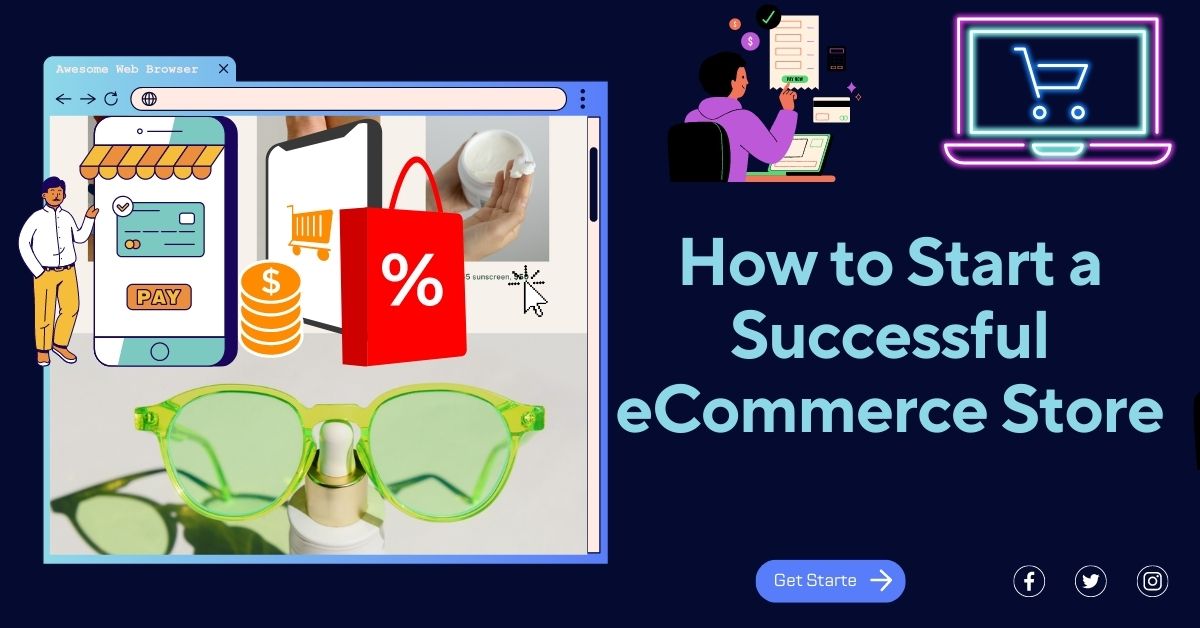To start a successful ecommerce store, you must carefully plan and execute a strategic approach. In this competitive online market, building a strong brand, conducting market research, selecting the right products and platform, optimizing for search engines, and implementing effective marketing strategies are crucial for success. We will guide you in this blog on how to start a successful ecommerce store.
With the increasing popularity of online shopping, establishing an ecommerce store has become more accessible and lucrative. This article will guide you through the fundamental steps to create and run a thriving ecommerce store, maximizing growth and profitability for your business.
Whether a beginner or an experienced entrepreneur, these expert tips will help you navigate the ecommerce landscape and achieve long-term success.

Credit: www.algolia.com
Table of Contents
Setting Up Your Ecommerce Store
So, you’ve made the decision to start your own ecommerce store. Congratulations! Now it’s time to set up your online shop and get things rolling. This section will cover the key steps and considerations for setting up your ecommerce store and ensuring its success.
Follow these guidelines to choose the right ecommerce platform, optimize your store’s design and layout, and implement secure payment gateways.
Choosing The Right Ecommerce Platform
When it comes to selecting the right ecommerce platform for your store, there are a few factors to consider. Here are some key points to keep in mind:
- Research and compare different ecommerce platforms to find one that aligns with your business needs and goals.
- Look for user-friendly platforms that offer customization options, mobile responsiveness, and scalability as your business grows.
- Consider the ease of integrating third-party tools and plugins and compatibility with different payment gateways.
- Evaluate each platform’s pricing plans and fees, considering your budget and projected sales volumes.
- Take advantage of free trials and demos to get hands-on experience with the platforms before deciding.
Optimizing Your Store’S Design And Layout
The design and layout of your ecommerce store play a crucial role in attracting and engaging customers. Here are some tips to optimize your store’s design:
- Create a visually appealing and professional-looking website with a clean and uncluttered design.
- Use high-quality product images and videos to showcase your products effectively.
- Ensure your website is easy to navigate, with clear categories, search functionality, and filtering options.
- Optimize your website for mobile devices to cater to the growing number of mobile shoppers.
- Implement a responsive design that adjusts seamlessly to different screen sizes and resolutions.
Implementing Secure Payment Gateways
One of the most critical aspects of running an ecommerce store is ensuring secure payment transactions. Here’s what you need to do:
- Choose reputable and secure payment gateways that support various payment methods.
- Display trust signals on your website, such as SSL certificates and security badges, to instill confidence in your customers.
- Regularly update and patch your ecommerce platform and payment gateway to protect against potential security vulnerabilities.
- Encrypt customer payment information and avoid storing sensitive data unnecessarily.
- Provide clear and transparent refund and cancellation policies to build customer trust.
Following these steps and correctly setting up your ecommerce store with Laganoo create a strong foundation for your online business. A well-designed store with a secure payment gateway will attract customers and keep them returning for more.
So, let’s continue our journey toward ecommerce success!
Building A Strong Product Strategy

Starting a successful ecommerce store requires careful planning and strategic decision-making. Developing a solid product strategy is crucial to building a strong foundation for your store. By focusing on key elements such as identifying profitable niche markets, sourcing high-quality products, and creating a compelling product catalog, you can set your ecommerce store up for long-term success.
Let’s dive into each of these components in more detail.
Identifying Profitable Niche Markets
Regarding ecommerce, finding a profitable niche market is essential for success. Here are some key points to consider:
- Conduct thorough market research to identify untapped niche markets with high demand and low competition.
- Analyze consumer trends, preferences, and purchasing behavior to identify profitable product categories within your chosen niche.
- Look for niche markets that align with your interests, knowledge, and expertise to ensure a genuine and authentic connection with your audience.
- Consider the profitability potential by evaluating factors such as market size, growth rate, and profit margins.
- Keep an eye on emerging trends and evolving customer needs to stay ahead of the competition and adapt your product strategy accordingly.
You get here high-paying niche markets such as Impact and ShareASale.
Sourcing High-Quality Products
Once you have identified your niche market, the next step is sourcing high-quality products that align with your brand and meet customer expectations. Consider the following:
- Research and vet potential suppliers, manufacturers, or wholesalers to ensure they meet your quality standards and can consistently deliver products on time.
- When selecting suppliers, consider factors such as product quality, reliability, pricing, and customer reviews.
- Establish strong relationships with suppliers to negotiate favorable terms, secure competitive pricing, and maintain a reliable supply chain.
- Consider factors like product uniqueness, exclusivity, and customization options to differentiate yourself from competitors and provide value to your customers.
- Regularly assess and evaluate product quality to ensure consistency and customer satisfaction.
Creating A Compelling Product Catalog on how to start a successful ecommerce store
A compelling product catalog is essential for attracting customers and convincing them to make a purchase. Here’s how you can create an enticing catalog:
- Use high-quality product images that showcase your products from different angles and perspectives.
- Write concise, persuasive product descriptions highlighting unique features, benefits, and value propositions.
- Organize your product catalog logically and user-friendly, using categories, filters, and search functionality to aid navigation.
- To build trust and credibility, incorporate social proof elements such as customer reviews, ratings, and testimonials.
- Continuously update and expand your product catalog to keep it fresh, relevant, and appealing to customers.
By focusing on these key aspects and building a strong product strategy, you’ll be well on your way to creating a successful ecommerce store that attracts customers, drives sales, and establishes a strong brand presence in the market. Remember, consistency, adaptability, and customer-centricity are key to sustaining long-term success in the competitive world of ecommerce.
Effective Marketing Strategies
Starting an ecommerce store can be an exciting venture, but it’s crucial to have effective marketing strategies in place to ensure its success. Developing a targeted marketing plan, utilizing social media marketing tactics, and implementing email marketing campaigns are key areas to focus on.
Let’s explore how to start a successful ecommerce store with these strategies in more detail.
You Read also: How to Create Powerful Email Templates with Canva
Developing A Targeted Marketing Plan:
- Identify your target audience: Research your target market and understand their demographics, preferences, and purchasing behavior.
- Set clear goals: Define measurable objectives for your marketing campaigns, such as increasing website traffic, improving conversions, or boosting brand awareness.
- Create buyer personas: Build detailed profiles of your ideal customers, including their needs, pain points, and motivations.
- Conduct competitor research: Analyze your competitors’ marketing strategies to identify potential opportunities and areas for differentiation.
- Choose the right channels: Select the most appropriate marketing channels to reach your target audience effectively, be it search engine marketing, content marketing, or influencer marketing.
- Develop a budget: Allocate resources strategically to different marketing activities, maximizing your return on investment.
Utilizing Social Media Marketing Tactics:
- Choose the right platforms: Determine which social media platforms your target audience frequents the most, such as Facebook, Instagram, or LinkedIn.
- Create engaging content: Craft compelling posts, images, and videos that resonate with your target audience and align with your brand voice.
- Foster community engagement: Interact with your followers, promptly respond to comments and messages, and create a sense of community around your brand.
- Leverage influencer partnerships: Collaborate with your industry’s social media influencers or micro-influencers to expand your reach and gain credibility.
- Employ paid advertising: Explore paid advertising options on social media sharing platforms to target specific audience segments and increase brand visibility.
Implementing Email Marketing Campaigns:
- Build an email list: Encourage website visitors, customers, and social media followers to subscribe to your email list by offering exclusive content, discounts, or incentives.
- Segment your email list: Divide your subscribers into different segments based on their interests, preferences, purchase history, or demographics to deliver personalized and relevant content.
- Craft compelling emails: Create engaging email templates and write attention-grabbing subject lines to entice recipients to open and read your emails.
- Offer valuable content: Provide valuable information, product updates, special promotions, or exclusive offers through your email campaigns to keep subscribers engaged.
- Test and optimize: Continuously a/b test different subject lines, content formats, and calls-to-action to improve email open rates, click-through rates, and conversions.
By implementing these effective marketing strategies, you’ll be well on your way to starting a successful ecommerce store. Remember to continuously evaluate your results, adapt your strategies based on data-driven insights, and stay up-to-date with the latest industry trends to stay ahead of your competition.
Streamlining The Order Fulfillment Process
Starting an ecommerce store can be an exciting and rewarding venture. However, one key aspect that can make or break the success of your business is the order fulfillment process. Streamlining this process ensures you can efficiently manage orders, inventory, and shipping, resulting in satisfied customers and a thriving business.
We will discuss three crucial steps to streamline your order fulfillment process: choosing the right order management system, implementing efficient inventory management, and ensuring smooth shipping and delivery. Let’s delve into each of these steps in detail.
Which is the best for your Store Speed optimization: Litespeed Cache Vs Wp Rocket
How to start a successful ecommerce store for Maximizing Conversion Rates

Starting an ecommerce store can be an exciting venture filled with potential. However, you must maximize your conversion rates to unlock that potential and turn visitors into customers. Two essential aspects of this process are optimizing product descriptions and images and testing and tweaking your website’s conversion elements.
Additionally, offering discounts and promotions can help drive sales. Let’s explore each of these strategies in more detail:
Optimizing Product Descriptions And Images:
- Craft compelling and accurate product descriptions highlighting your offerings’ features, benefits, and unique selling points.
- Use persuasive language to engage your audience and create a sense of desire for your products.
- Incorporate relevant keywords naturally within your descriptions to improve search engine visibility.
- Ensure your product images are high-quality, visually appealing and showcase the product from various angles.
- Use descriptive alt tags for your images to optimize accessibility and improve search engine rankings.
You create high-quality images with Canva
Testing And Tweaking Your Website’S Conversion Elements:
- Conduct a/b testing to compare different website versions and identify which elements most effectively convert visitors into customers.
- Test various aspects of your website, such as call-to-action buttons, placement, and color schemes, to determine the most compelling combinations.
- Monitor user behavior through analytics tools to understand how visitors engage with your website and identify potential areas for improvement.
- Continuously experiment and make incremental changes based on data and customer feedback to optimize your website’s conversion rate.
Offering Discounts And Promotions To Drive Sales:
- Implement time-limited discounts or promotions to create a sense of urgency and encourage immediate action.
- Provide incentives such as free shipping or a gift with purchase to entice customers to complete their purchases.
- Leverage email marketing and social media platforms to distribute exclusive discount codes or announce limited-time offers.
- Consider partnering with influencers or running collaborations to drive traffic and increase visibility for your store.
- Regularly assess the performance of your discount and promotion strategies, making adjustments as needed to achieve optimal results.
By optimizing your product descriptions and images, testing and tweaking your website’s conversion elements, and offering compelling discounts and promotions, you can maximize your ecommerce store’s conversion rates. Remember, continuous experimentation and customer feedback are crucial for ongoing improvement. So, don’t be afraid to try new strategies and adapt to your target audience’s evolving needs and preferences.
Providing Exceptional Customer Service
Starting an ecommerce store can be an exciting venture, but success relies heavily on providing exceptional customer service. In today’s competitive marketplace, customers expect a seamless shopping experience and outstanding support from the businesses they interact with. To ensure your ecommerce store thrives, it is crucial to implement strategies that prioritize customer satisfaction.
Implementing Live Chat Support
One effective way to enhance customer service is by implementing live chat support on your ecommerce store. This feature lets customers interact with a representative in real-time, instantly helping them resolve queries or concerns. The benefits of live chat support include the following:
- Increased customer satisfaction: Live chat provides immediate assistance, leading to quicker problem resolution and higher customer satisfaction.
- Boost in sales: Promptly addressing customer questions can eliminate potential purchasing barriers and increase conversion rates.
- Personalized interaction: Live chat enables personalized conversations, allowing you to build a rapport with customers and cater to their individual needs.
Offering Hassle-Free Returns And Exchanges
Another essential aspect of exceptional customer service in ecommerce is offering hassle-free returns and exchanges. Providing an easy and straightforward returns process can help alleviate customer concerns and encourage repeat purchases. Here are some key points to consider:
- Clear return policy: Clearly outline your return policy on your website, including information on initiating a return or exchange and any associated costs, if applicable.
- Streamlined process: Simplify the returns process by offering prepaid return labels, online return forms, and clear instructions on packaging and shipping.
- Prompt refunds: Process refunds or exchanges swiftly once the returned items have been received, keeping customers informed throughout the process.
Collecting And Responding To Customer Feedback
Collecting and responding to customer feedback is essential to providing exceptional customer service. This valuable information can help you identify areas for improvement and understand your customers’ needs better. Here’s how you can effectively manage customer feedback:
- Feedback channels: Provide multiple channels for customers to share their opinions, such as email, surveys, or social media platforms, ensuring you capture feedback from a broader range of customers.
- Active listening: Regularly monitor and analyze customer feedback, highlighting recurring themes or concerns. This shows customers that you value their thoughts and are committed to making necessary improvements.
- Timely responses: Reply to customer feedback promptly, acknowledging their input and providing potential solutions or explanations. This demonstrates your dedication to customer satisfaction and builds trust.
By implementing live chat support, offering hassle-free returns and exchanges, and actively collecting and responding to customer feedback, you can provide exceptional customer service that sets your ecommerce store apart from the competition. Remember, a satisfied customer is likely to become a repeat customer and a brand advocate, contributing to the long-term success of your online business.
Leveraging Data And Analytics
Starting an ecommerce store can be an exciting and rewarding venture. However, in order to set yourself up for success, it’s important to leverage data and analytics to drive growth and make informed decisions. You can optimize your store and maximize profits by tracking key performance indicators (KPIs), analyzing customer behavior and purchase patterns, and making data-driven decisions.
This section will explore these strategies in detail, providing valuable insights to help you start and run a successful ecommerce store.
Tracking Key Performance Indicators (KPIs)
- Tracking KPIs, such as website traffic, conversion rate, and average order value, can provide valuable insights into the performance of your ecommerce store.
- By monitoring these metrics, you can identify areas of improvement and make data-driven decisions to optimize your store’s performance.
- Some key KPIs to track include customer acquisition cost (CAC), customer lifetime value (clv), and return on ad spend (roas).
- Use analytics tools like google analytics or ecommerce platforms’ built-in analytics to easily track and measure these KPIs.
Analyzing Customer Behavior And Purchase Patterns
- Analyzing customer behavior can help you understand how customers interact with your store and make purchase decisions.
- Tools like heatmaps, click-tracking, and user flow analysis can provide insights into what areas of your website are most engaging and which ones need improvement.
- Purchase patterns analysis can help you identify popular products, high-converting pages, and customer preferences, allowing you to optimize your store accordingly.
- By understanding your customer’s behavior and preferences, you can personalize their shopping experience and increase conversions.
Making Data-Driven Decisions For Growth
- The success of your ecommerce store relies on making informed decisions supported by data.
- Analyzing data can help you identify trends, spot opportunities, and address pain points.
- Use a/b testing to experiment with different strategies and measure their impact on key metrics.
- Leverage customer feedback and reviews to gain insights into product improvements or new product ideas.
- Regularly analyze your data and adjust your marketing, pricing, and product strategies based on the insights gained.
Leveraging data and analytics is crucial for the success of your ecommerce store. Tracking KPIs, analyzing customer behavior, and making data-driven decisions will empower you to optimize your store, enhance the customer experience, and drive growth. By harnessing the power of data, you can stay ahead of your competition and build a thriving ecommerce business.
Scaling Your Ecommerce Business
Starting and growing a successful ecommerce store requires a strategic approach and careful planning. As your business gains momentum, scaling becomes crucial in sustaining and expanding your growth. Key elements to consider are implementing automation and outsourcing, expanding into new markets and channels, and building a strong team to support your growth.
Implementing Automation And Outsourcing
- Automating repetitive tasks can save time and resources. Consider using tools and software to streamline processes such as inventory management, order fulfillment, and customer service.
- Outsourcing certain tasks, such as shipping and customer support, can also free up your time to focus on more critical aspects of your business.
- By implementing automation and outsourcing, you can minimize errors, improve efficiency, and allow your business to operate smoothly as it scales.
Expanding Into New Markets And Channels
- Explore new markets by identifying untapped customer segments or geographic regions that align with your target audience. Conduct market research to understand these potential markets better.
- Consider expanding into additional sales channels, such as marketplaces, social media platforms, or brick-and-mortar locations, to reach a broader customer base.
- Adapting your marketing strategies to cater to these new markets’ specific needs and preferences will help you seize growth opportunities.
Building A Strong Team To Support Growth
- As your ecommerce business grows, building a capable and reliable team becomes essential.
- Hire individuals with the necessary skills and experience to handle various aspects of your business, such as marketing, operations, and customer service.
- Foster a collaborative work environment and provide ongoing training and development opportunities to help your team stay aligned with business objectives and adapt to changes as you scale.
Remember, scaling your ecommerce business is a continuous process that demands flexibility, adaptability, and constant evaluation. By implementing automation and outsourcing, expanding into new markets and channels, and building a strong team, you can position your ecommerce store for long-term success and achieve sustainable growth.
Frequently Asked Questions Of How To Start A Successful Ecommerce Store
How Can I Choose The Right Platform For My Ecommerce Store?
Evaluate features, pricing, scalability, and user-friendliness of platforms like Shopify, woocommerce, and Bigcommerce.
What Essential Features Should My Ecommerce Store Have?
Ensure your store has a responsive design, reliable payment gateway, efficient inventory management system, and customer review integration.
How Can I Drive Traffic To My Ecommerce Store?
Utilize social media marketing, SEO optimization, content creation, influencer partnerships, and email marketing to attract and engage potential customers.
Conclusion
Starting a successful ecommerce store requires careful planning, effective strategies, and a clear understanding of your target audience. Following the tips outlined in this blog post can set you up for long-term success. Conduct thorough market research to identify a profitable niche and understand your competitors.
Create a well-designed, user-friendly website with seamless navigation and intuitive checkout. Utilize effective SEO techniques to improve your website’s visibility in search engine results and drive organic traffic. Build a strong online presence by leveraging social media, influencer marketing, and email marketing campaigns.
Providing exceptional customer service, optimizing product listings, and continuously analyzing and adapting your strategies based on data will help your ecommerce store thrive in the competitive landscape. With dedication, perseverance, and a willingness to learn and adapt, you can create a successful online business that generates consistent revenue and satisfies your customers’ needs.
Recent Posts You May Like:
- Which is Better Prowritingaid Vs Grammarly
- Grammarly Vs Chatgpt
- How to Add Grammarly to Gmail Easily – Boost Your Writing
- Revolutionize SEO with Magic Page Plugin: Masterclass!
- The Ultimate Guide to Using Grammarly for PowerPoint in English
- Shaulson Blog: Power up your content strategy with expert tips
- How to Invert Colors in Canva: Unleash Your Creativity
- How to Make an Image White on Canva: Simple Steps for Perfectly Blank Background
- Rankactive SEO Review: The Power of Effective Optimization
- Best A2 Hosting Alternatives : Top-Notch Options for Superior Performance
- How to Transfer Domain from Godaddy to Namecheap: A Hassle-Free Migration Solution
- Best AI Tools for Affiliate Marketing: Boost Your Marketing Success












